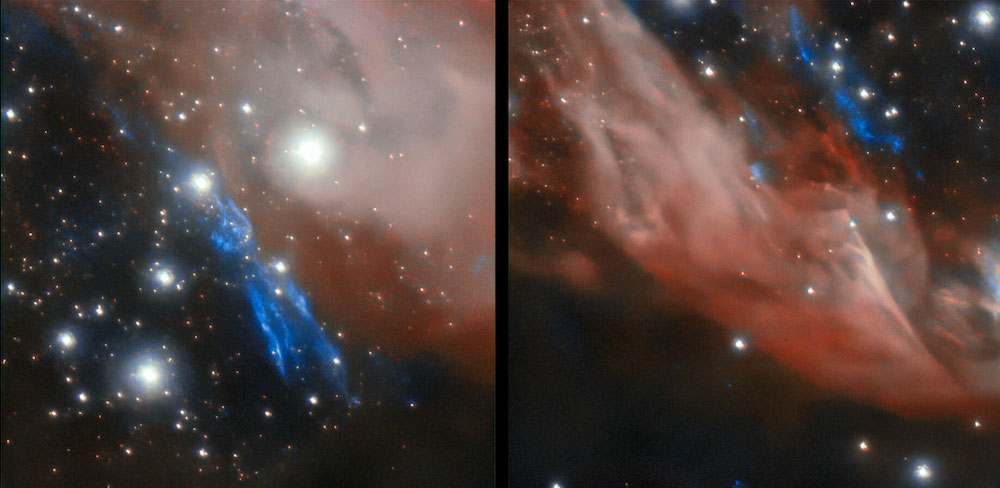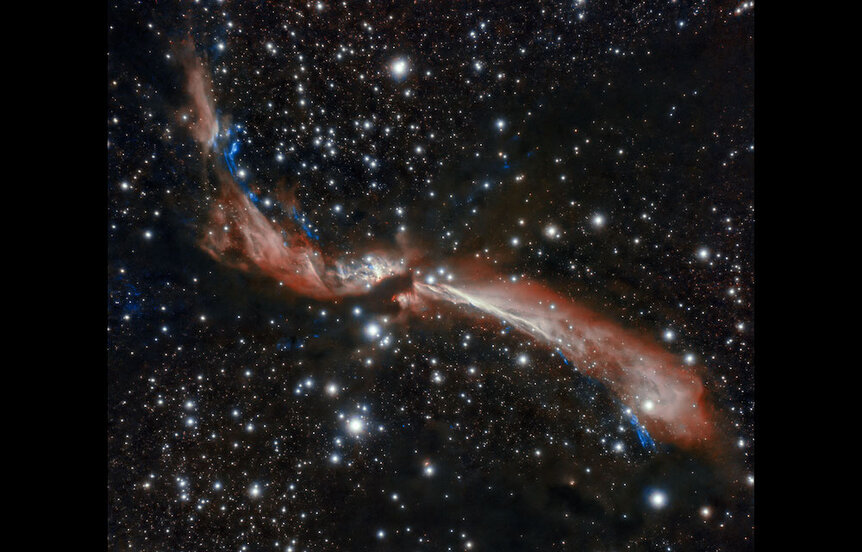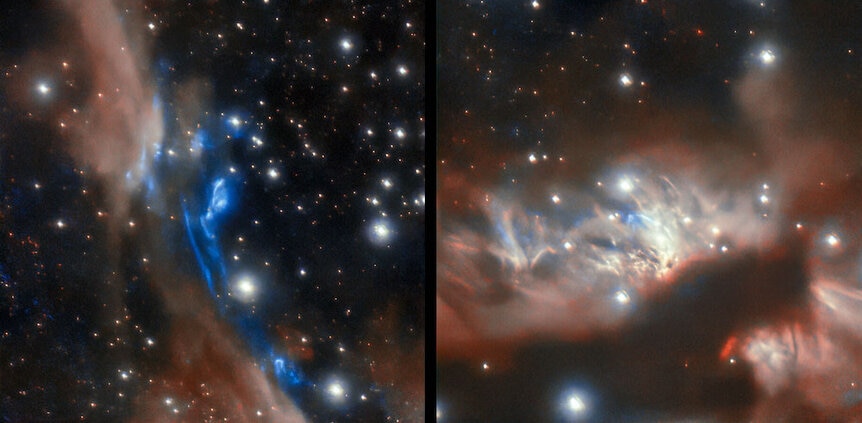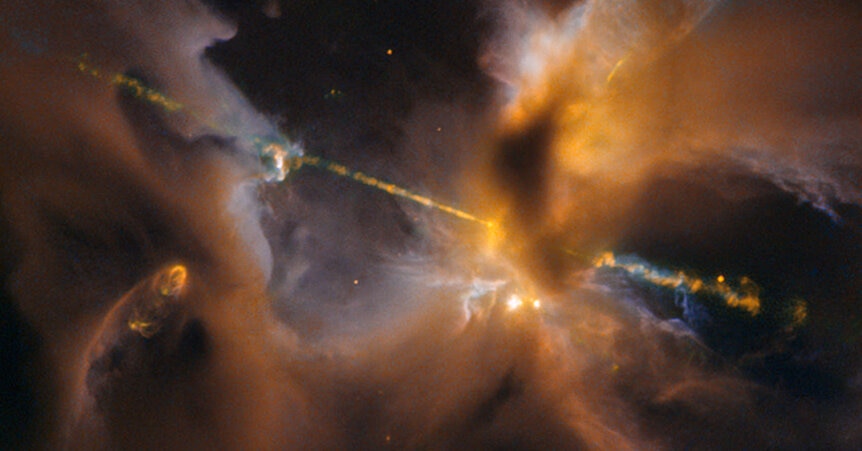Create a free profile to get unlimited access to exclusive videos, sweepstakes, and more!
Massive baby blows out 50 trillion-km-long gas blast. And it's beautiful.
Baby stars belch out gorgeous structure.

When stars are young, they can throw some pretty big tantrums.
A fraction of them blast out incredible outflows of material, gas and dust shot away from the star. These come in many shapes and sizes, but sometimes the young star will create immensely long and very thin jets, like beams from a lighthouse but much more tightly focused.
These can be very long, stabbing out into the dark like light sabers, as is the case, for example, of Herbig-Haro 24 — in fact these are in general called Herbig-Haro objects. But these jets aren't always straight. Sometimes they curve, and when they do they show us both astonishing beauty as well as amazing science.
That is very much the case for MHO 2147, a young star about 10,000 light years away in the constellation of Ophiuchus:
Holy wow!
This was taken using the huge Gemini-South telescope in Chile, and shows this gorgeous object in infrared light, just outside the range of color our eyes can see.
MHO stands for Molecular Hydrogen emission-line Object, which is a mouthful. Cold hydrogen atoms can bond together to form H2, molecular hydrogen. When an electron in that molecule jumps down from one energy level to another it emits a very specific wavelength — color — of light in the infrared. Astronomers call these narrow wavelength range colors lines… and there's where MHO comes from.
The MHO catalog contains thousands of such objects, some of which are young stars blowing out these jets. What makes MHO 2147 so very interesting is that the jet is clearly curved. But it's even cooler than that: on one side the jet curves up, and on the other it curves down. This is called an S-curve for obvious reasons, but more technically it's referred to as point symmetry: If you rotate one jet around the point in the center, it has the same curvature as the other jet.
What causes that?
The jets themselves are likely caused by material in a huge disk surrounding a star from which the star is forming. This material gains a lot of energy as it falls toward the star. The disk can have an embedded magnetic field, and the star has one as well. This can lift material out of the disk as it falls in and blast it out away from the star's magnetic poles, up and down, away from the disk. That's what forms the jets.
So why are they curved? Sometimes the star is not alone. If it has a binary companion, a second star orbiting it, that star's gravity tugs on the jet-making star, causing it to wobble. This is the same idea that causes a top to wobble as it spins on a table top: The friction with the surface causes a torque on the top, and its rotational axis itself rotates. This is called precession, and it's a very common effect in astronomy. The Moon's gravity on Earth causes its axis to precess every 26,000 years, for example.
MHO 2147 has a star at its heart, called IRAS 17527−2439. The astronomers who looked at MHO 2147 estimate it is a beast, 111 times the Sun's mass and likely thousands of times more luminous (link to paper). It's young, something like 30,000 years old, and does have a disk of material around it probably from 750 to 4.5 billion kilometers out — 5 – 30 times the Earth-Sun distance. All this together is what generates powers those gorgeous long which, mind you, are five light years from tip to tip. 50 trillion kilometers. This is a big structure.
And, it turns out, the astronomers find that it's very likely a trinary star, three stars orbiting each other, a single star separated from a binary system about 300 billion km away. This is not so easy to see in the image due to a huge and incredibly thick dark cloud blocking a lot of the light near the center of the jets. As it is they suggest the central star is a trinary, but cannot say for sure.
If you look closely there's a series of faint blue knots of hydrogen gas perpendicular to the main jets that may be from a different star in that system, though by my eye the one on the bottom curves in the same way the main jet does. And, on top of that, there are also blue jets tracing along the path of the main jets — the one on the left is just above it, and the one on the right just below.
Obviously, the details of the system are a bit complicated. It's possible the main jets and the ones adjacent are driven by different sources, for example. I'm scratching my head over that; the fact that they are parallel makes me think it's the same star that blew them out and that over time the direction of the jets in has changed, but then why are the jets so different in structure? It's weird, and not clear what's going on here.
I wonder if the Sun looked a bit like this when it was born. Maybe not; it's not nearly as massive as the powerhouse in the center of MHO 2147, and not all stars go through a Herbig-Haro stage. But this is still showing us that some stars do have complex and energetic childhoods, especially if other young stars are around.
I'm always amused by the parallels between human childhood and that of stars. It's anthropomorphism, certainly, but still fun to think about. Violent tantrums, behavior issues especially when others are around, and — not to be indelicate, but science is science — spewing out of both ends.
As above, so below, I suppose.






























